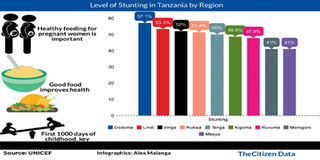Hidden hunger threatens TZ’s mothers and infants

What you need to know:
- According to the World Bank, Tanzania has a teenage mother population of about 26 per cent. Many of these girls aged 15 to 19, are often out of school or drop out as a consequence of falling pregnant.
Happiness Salum like about 7 million other young women in Tanzania, is a teenage mother. The 17-years-old fell pregnant just after completed her primary school education in Kasulu District, Kigoma Region. Happiness believes her circumstances would be different if she was dealt a better hand in life. She is not only a teenage and single mother, but is the mother of a two-year old boy suffering from stunted growth.
According to the World Bank, Tanzania has a teenage mother population of about 26 per cent. Many of these girls aged 15 to 19, are often out of school or drop out as a consequence of falling pregnant.
Happiness spent most of her childhood working at her family tavern at her home. She and her three sisters went to school but spent most of the time before and after school hours helping their mother run the family pub.
Happiness recalls that dealing with drunken ruthless male customers was the order of the day. She says doesn’t even know who exactly the father of her child is. No one supported her during her pregnancy except her elderly mother.
Happiness and her mother like about 28 million other Tanzanian women, live under poor conditions. According to the World Economic Forum Tanzania gender inequalities are responsible for lower literacy rates and ‘healthy life expectancy’ amongst its women population. Healthy life expectancy is the number of years a woman can expect to live a healthy life.
“We were four sisters, unfortunately my three elder sisters passed away after long illnesses. Our lives became miserable as we struggled for food. We usually have one meal per day. So you can imagine pregnancy without a balance diet,” she says.
Happiness, as a single mother, and out of school teen is set for a low health life expectancy. She is likely to enjoy fewer years in good health due to disease, malnutrition and even physical and sexual violence.
Most of women in rural areas don’t know the importance of good nutrition in order support the rapid growth and development of babies and young children during their first 1,000 days.
This can be attributed to poverty and Tanzania’s gender gap problem which leaves many women in low income status as they are excluded from the economy, resources, land and education.
Even after giving birth, Happiness’ breastfeeding routine was not consistent because she couldn’t produce enough milk, she supplemented her milk with cassava and porridge.
“Whenever I go to the clinic, nurses talk about balance diet; that we need to feed our children with the right foods to help them grow well, unfortunately I can’t afford it. Life is so difficult.”
According to the 2014 Tanzania National Nutrition Survey final report; between 2010 and 2014, chronic malnutrition – stunting, or low height for age – among under five children in the country dropped from 42 per cent to 35 per cent.
However, malnutrition is more prevalent in rural areas than urban areas, while it is also presence is large in uneducated households than educated ones.
Available data from U shows that 58 percent of stunting cases in Tanzania takes place in 10 of the 30 regions in Tanzania. Kigoma Region, where Kasulu District is located, has 48.6 per cent prevalence rate of malnutrition.
The report also shows that some regions with stunting level in the brackets as Dodoma (57.1), Lindi (53.3), Iringa (52) and Rukwa (51.4), Mbeya (41), Tanga (50), Ruvuma (47.4) and Morogoro (41).
Medical doctors and nutritionists say stunted growth starts in the womb if an expectant mother is not eating a balanced diet. Stunting is more common among children who were very small at birth, those with a thin mother and those from the poorest households.
According to mother child nutrition.org, the main underlying preconditions that determine adequate nutrition are food, health and care: the degree of an individual's or a household's access to these preconditions affects how well they are nourished.
Action Against Hunger, says lack of access to food is among the underlying causes of chronic malnutrition. According to them, stunting does not occur due to lack of food, but rather due to poverty as “people are too poor to obtain enough food.
With more that more than 2.7 stunt children, 446,000 underweight and 106,000 others with malnourished, a lot needs to be done, from household to national level to address the situation. Putting more efforts in eradicating poverty, assuring food security, quality healthcare as well as availability of clean and safe water, could save children from suffering from chronic malnutrition.




